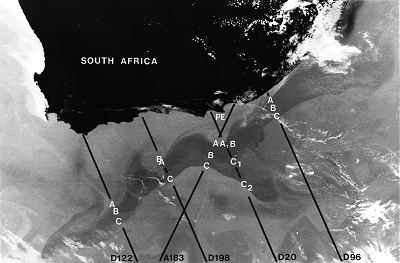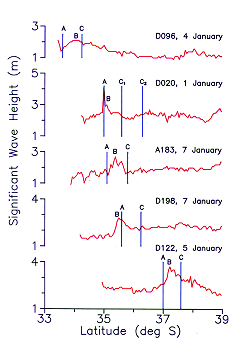TOPEX/POSEIDON observes wave enhancement in the Agulhas current
M.L. Gründlingh (NRIO, South Africa)
A number of vessels passing around the tip of the African continent have been damaged by so-called giant waves generated through interaction between the Agulhas Current flowing southwestwards and waves propagating northeastwards.
Significant wave height (SWH) data collected by the TOPEX/POSEIDON satellite were inspected for evidence of wave enhancement in the Agulhas Current. NOAA satellite infrared images provided the position of the Agulhas Current at the time of the TOPEX/POSEIDON satellite overpass, and a time limit of three days between the crossing of the two satellites was applied.

A large number of such wave enhancements were found in the TOPEX/POSEIDON data. As an example, conditions observed in January 1993 are presented. The NOAA image of 2 January 1993 shows the Agulhas Current as a ribbon of warm water flowing southwestwards along the east coast (Figure 1). Off Port Elizabeth and further downstream the linear flow of the current is perturbed by meanders of various dimensions.

Five orbits of TOPEX/POSEIDON (Figure 1) traversing the region of the infra-red image (D96: 4 January; D20: 1 January; D198: 7 January; A183: 7 January; D122: 5 January) show peaks of different amplitudes in the Agulhas Current (Figure 2). Along pass D20 the peak was sharp and located at the inshore edge of the current. Small mismatches (e.g. on 7 January) between the positions of peak enhancement and the "core" of the Agulhas Current can be ascribed to a lateral displacement of the current over the period between the passage of the two satellites. Decreases (attenuations) of the SWH were observed in the area of the eastward flowing Agulhas Return current, where the waves are often aligned with the current.




